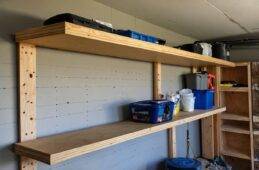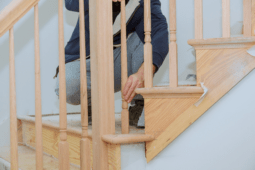How to: Make DIY Wall-Mounted Succulent Shelves

I’ve lived in my house for three years, and I have but one giant blank white wall left: the one across from my bedroom headboard, the first thing I see when I wake up. For the past thirty-six months, I’ve been slowly filling my walls with DIY art projects, screenprints from my favorite artists, even a full-on collage of colorful paint samples glued to the plaster (which are never coming off, by the way). But this guy…taunts every morning. Or, had been. Cause last weekend, I decided to do something about it. Rather than make another piece of static two-dimensional art, I wanted to come up with something with a little more texture, and that I could adapt and change as time and seasons change. Since that wall is adjacent to a window and gets reasonable sun, I also thought it might be fun to incorporate something living in as well. And then – idea boom: lightweight display shelves with built-in plants. I whipped all three of these up in a single afternoon with easy-to-find tools and hardware from my local True Value hardware store.
Tools and materials:
- 1″ thick (4/4) wood stock at least 36″ long
- 2 1/2 x 5/8″ metal corner braces and accompanying screws
- Spray paint
- Scrap wood, MDF, luan, or fiberboard
- Saw – any will do, or have your pieces cut at the hardware store
- Hole saw or forstner bit – 2 3/4″ – 3″ diameter
- Electric drill and drill bits
- Sandpaper or electric sander
- Wood finish, such as polyurethane or shellac and paste wax
- Wall anchors and screws

1. My project began with a length of 1″ thick walnut. I chose this piece because it was already milled with 90-degree edges at 5″ wide, meaning I wouldn’t have to make any rip cuts to size it up. I also loved the color variation between the sap wood (light) and heart wood (dark), and it knew its rich tones would complement the painted hardware well. This project used about $7.00 of the wood (not quite half of the $16.00 piece), but you could go super inexpensive with a basic fir or pine 1×6″.

2. Decide how long you’d like your shelves to be. I cut mine at 18″ using my compound miter saw and a quality crosscut blade, which is essential if your using hardwoods.

3. Next draw a line down the center (2 1/2″) and set up your plants. I chose three various succulents that would work well in medium-light solutions, in 3″ pots. I picked only one with spines, in case I ever stumbled around in the dark, and set it the furthest from my common traffic paths. Mark where your plants will set into the shelves with a pencil, then transfer the y-axis to your center line. Note: if you do go with walnut, try using a white colored pencil or crayon for this task. Graphite is hard to see!

4. Next, drill out the holes with a hole saw or Forstner bit. I used a 2 3/4″ hole saw, but if you already have a 3″ bit, it’ll work fine; since the pots are tapered, it’ll just sit at a different spot. (I tested!) If you’re using a hardwood, I recommend placing a sacrificial piece of wood or fiberboard on either side of the hole to prevent any tearout from the rather rough hole saw. When working with wood, it’s always best when the blade or bit enters and exits your workpiece through wood for the cleanest cut. You can see my setup in the photo above.
Additional thoughts: If you wanna up your craft and DIY game, I highly recommend grabbing a benchtop drill press. They’re not much more expensive than a high-quality hand drill, and allow you to try all sorts of new projects. They’re are so many tasks that would have been a beast to have completed without one…at least, for a perfectionist like me.

5. Since I have a router table and a roundover bit was already installed, I ran all the edges and the planter recess through it once. This is a totally optional step, but…again, perfectionist. And, it only took, like, four extra minutes.

6. Next, get to the sanding! Depending on how rough your surface was to begin with, you can start around 100 or 150, then move up to a 220 grit. I also sanded the end-grain to 320 for an even color match. You can learn more about that technique here.

7. The hardest part of making shelves from scratch is the lack of easy bracket or mounting options. There are track systems that work well, as well as 90-degree brackets, but both were overkill for a lightweight project like this. Since I knew I was never going to add more than 10-15 lbs to any individual shelf, I simply opted for steel corner braces, 2 1/2 x 5/8″. You can size yours up or down depending on the depth of your shelf. My local True Value had them in basically every size from 1-6″, so you can pick the size that suits your project best. Coupled with some solid drywall anchors, I felt confident that this would support the weight.
Take yours outside and spray paint to add a little more design-y detail to your project. I chose a few colors from cans I already had that I thought would match the rich walnut well.

8. Because I chose walnut, a rather coarse-grained wood, I opted to use a dewaxed shellac as my finish, this can from Zinnser, specifically. It’s non-toxic and won’t darken the wood, and gives a mid-gloss sheen, which I prefer over shiny wood. If I really wanted to enhance the richness of the walnut, I’d rub a few coats of Danish oil. Either way, I would (and did) finish it with a hand rubbed coat of paste wax, which can be recoated every few years if necessary. The wax helps to protect the surface and even out the sheen, as you can see in the photos.

9. Lastly, use the holes in the braces to mark pilot holes for the included screws, and drill an 1/8″ diameter hole about 5/8-3/4″ through the shelf.
 Two colors of sawdust from the same wood! (Nerd alert)
Two colors of sawdust from the same wood! (Nerd alert)

10. Then, just use the included screws to attach the braces to the shelf. Lastly, insert some medium-duty anchors into the wall, and attach with accompanied screws. Fill as desired, and change it up as often as you’d like. Enjoy!










